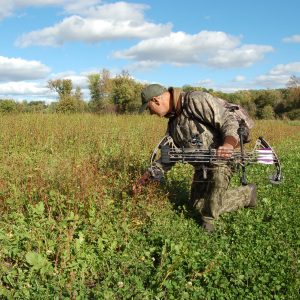The terms “no-till” or “no-plow” often gives rookie food plot farmers a false sense of hope. It tells them that it’s acceptable to cut out an important step in the planting process and everything will be OK. The problem being – these first-timers often don’t have the equipment necessary to complete all the plantings steps “according to the book.” The more steps you skip, the more you will sacrifice in attraction, yield and palatability to a point where you have a total failure. It is possible to plant a food plot without working/turning the soil; however, if you’re going to skip this very important action, some of the remaining steps become more essential and must be completed correctly.
- You must choose the right crop. You’ll need to use small seeds that have a planting depth of ½ inch or less. If you aren’t working the soil to prepare a deeper seedbed, you’ll have to utilize what Mother Nature has left you, so that means large seeds like corn, beans and peas with a planting depth of an inch or more will likely need to be passed on unless you have an implement that will bury the seeds the appropriate depth, or an awful lot of “elbow grease.” For late summer/fall planting there are numerous choices – products like Maximum, Deer Radish or Winter Bulbs & Sugar Beets should produce good stands in a no-till situation. You may also choose a blend like Hot Spot that is specifically meant for a no-till situation.
- You must choose a suitable location. A good rule of thumb for choosing a location is “if significant vegetation grew on the site during the prior growing season that normally indicates the soil, sunlight and moisture are suitable to sustain plant life in that spot.” Hot Spot is created to perform in as little as 4 hours of sunlight per day, but with six hours per day you should be able to grow most other plant types. Some people want to plant a no-till plot back in the “boonies” near their treestand where there’s only a bunch of matted-down leaves or pine needles. If there’s not something currently growing in the spot, what makes you think your food plot will grow any better?
- Make sure to eliminate the existing vegetation (competition). You don’t want your crop competing with native plants for sunlight, moisture and soil nutrients. Plain glyphosate (Roundup) is usually the best, easiest and least expensive choice for this job. There “were” ideal conditions at the spot for whatever native plants were growing there, now you need to remove those plants and create “ideal conditions for your new proposed crop.” If there ends up being a lot of dead plant residue or a layer of sod, that should be removed before planting.
- The appropriate amount of pH Fertilizer should be raked into the soil before planting. Besides having vital N, P and K nutrients for your soon to be germinating seedlings, this product also contains a fast acting lime. Without the ability to turn the soil and incorporate powdered lime, pH Fertilizer helps reduce soil acidity (raise the pH) quickly so your plants will be able to utilize soil nutrients properly. Finally, make sure your seeds make contact with the soil. For good germination the seeds must be planted the appropriate depth. After broadcasting, going over the area with a rake is a good idea to ensure good see-to-soil contact. You may also come back over the plot a few weeks after germination with an application of M.E.E.N. Green foliar applied liquid fertilizer to significantly boost growth.






